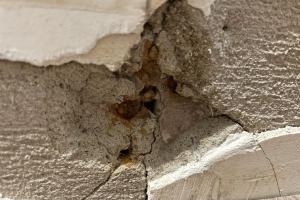Understanding Asbestos in Plaster Walls: Identification, Safe Removal, and Essential Insights

-
Quick Links:
- What is Asbestos?
- Why Was Asbestos Used in Plaster?
- Identifying Asbestos in Plaster Walls
- Health Risks Associated with Asbestos
- Testing for Asbestos
- How to Safely Remove Asbestos from Plaster
- Hiring Professionals for Asbestos Removal
- Legal Regulations and Guidelines
- Case Studies and Real-World Examples
- FAQs
What is Asbestos?
Asbestos is a naturally occurring mineral known for its heat resistance and insulating properties. Commonly used in construction materials for decades, asbestos can be found in various forms, including chrysotile (white asbestos), amosite (brown asbestos), and crocidolite (blue asbestos). Its use has been heavily restricted since the late 20th century due to health concerns.
Why Was Asbestos Used in Plaster?
Asbestos was added to plaster to enhance its durability, fire-resistance, and insulating properties. Builders favored it for its strength and effectiveness in preventing fires, leading to its widespread use in homes, schools, and commercial buildings until the 1980s.
Identifying Asbestos in Plaster Walls
Identifying asbestos in plaster walls can be challenging without professional testing. Here are some indicators you can look for:
- Age of the Building: If your home was built before 1980, there is a higher likelihood of asbestos being present.
- Texture and Appearance: Asbestos-containing plaster may have a unique texture. It may appear crumbly or have a fibrous look.
- Documentation: Check building records for any mentions of asbestos use.
Health Risks Associated with Asbestos
Exposure to asbestos can lead to severe health issues, including:
- Asbestosis: A chronic lung disease caused by inhaling asbestos fibers.
- Mesothelioma: A rare cancer linked to asbestos exposure, affecting the lining of the lungs.
- Lung Cancer: Increased risk for those who have been exposed to asbestos, especially smokers.
Testing for Asbestos
If you suspect asbestos is present in your plaster walls, testing is crucial. Here’s a step-by-step guide:
- Contact a Certified Asbestos Inspector: They can take samples safely.
- Sample Collection: The inspector will collect a small sample of the plaster for lab analysis.
- Lab Analysis: Samples are tested to determine the presence and percentage of asbestos.
How to Safely Remove Asbestos from Plaster
Removing asbestos is dangerous and should be done with caution. Here’s a comprehensive guide:
Step-by-Step Guide to Asbestos Removal
- Preparation: Seal off the area to prevent contamination.
- Protective Gear: Wear appropriate PPE, including masks, gloves, and coveralls.
- Wet the Area: Dampening the plaster reduces dust release.
- Careful Removal: Gently remove the plaster without breaking it to minimize fiber release.
- Disposal: Place the asbestos waste in labeled, sealed containers for safe disposal.
Hiring Professionals for Asbestos Removal
In many cases, hiring a licensed asbestos abatement contractor is the safest option. They have the expertise and equipment necessary to handle asbestos safely. Here are some tips for hiring professionals:
- Check for licenses and certifications.
- Read reviews and ask for references.
- Get multiple quotes before making a decision.
Legal Regulations and Guidelines
Asbestos removal is regulated by federal and state laws. Familiarize yourself with these regulations to ensure compliance. The Environmental Protection Agency (EPA) provides guidelines on asbestos handling:
Case Studies and Real-World Examples
Several case studies illustrate the importance of proper asbestos management:
Case Study 1: Residential Renovation
A homeowner in an older neighborhood discovered asbestos during a renovation. By hiring a certified contractor, they ensured safe removal, protecting their family's health.
Case Study 2: School District
A school district undertook a major renovation of a building built in the 1960s. Early testing revealed asbestos, prompting a full assessment and safe removal before work commenced.
FAQs
1. How can I tell if my plaster contains asbestos?
The only definitive way is to have it tested by a professional. Visual inspection can provide clues, but testing is necessary for confirmation.
2. Is it safe to leave asbestos-containing plaster in place?
If the plaster is intact and undisturbed, it may be safe. However, any renovation or disturbance can release fibers.
3. How much does it cost to remove asbestos?
Costs vary widely depending on the extent of the work, but removal can range from $1,500 to $30,000 or more.
4. Can I remove asbestos myself?
It is strongly discouraged unless you are trained and certified. DIY removal poses significant health risks.
5. What should I do if I discover asbestos?
Stop any work immediately and contact a certified asbestos professional for advice and testing.
6. Are there alternatives to asbestos in plaster?
Yes, there are many modern materials available that provide similar properties without the health risks.
7. How long does asbestos stay in the environment?
Asbestos fibers can remain airborne for long periods and can persist in the environment indefinitely.
8. What are the symptoms of asbestos exposure?
Symptoms can take years to develop and include coughing, shortness of breath, and chest pain.
9. What is the best way to reduce the risk of asbestos exposure?
The best way is to avoid disturbing materials that may contain asbestos and to have them professionally managed if necessary.
10. Can I sell a house with asbestos?
Yes, but you must disclose the presence of asbestos to potential buyers. Proper management and removal can enhance property value.
Random Reads